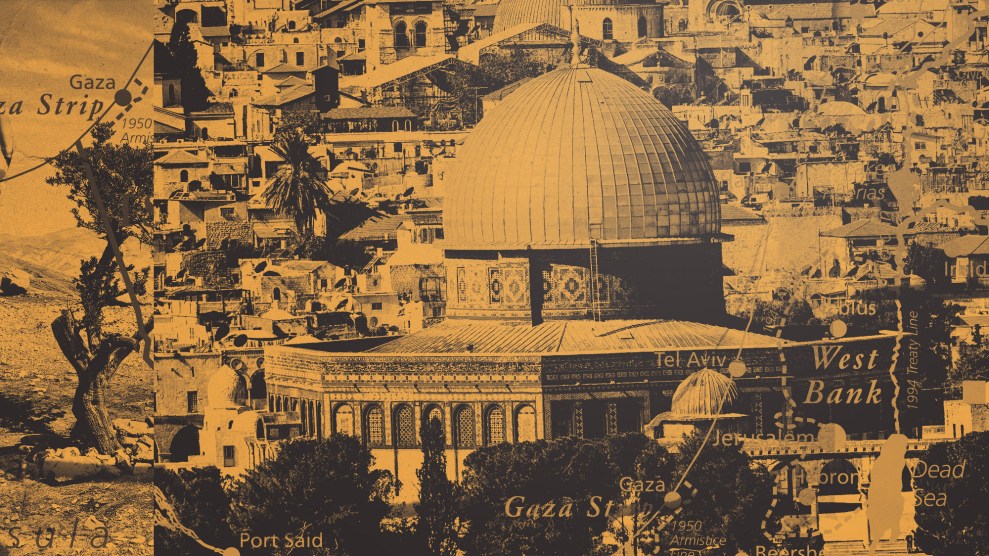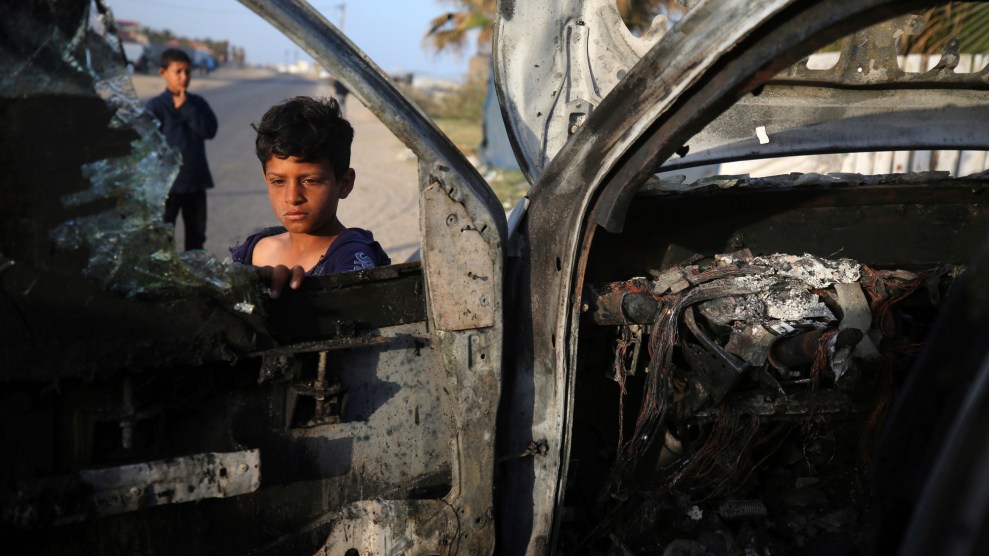
Mother Jones; Getty
Famine is already happening in parts of Gaza, a top US humanitarian official publicly acknowledged this week for the first time. After six months of Israeli war and blockades, an estimated 2.2 million people are facing acute or catastrophic food shortages. One in three children in northern Gaza are malnourished, and deaths due to hunger are expected to accelerate quickly, US officials have warned.
According to the groundbreaking work of Dutch researcher Dr. Tessa Roseboom, the impacts of near starvation are also likely being experienced by generations not yet born. Roseboom, a biologist and professor of early development and health at the Amsterdam UMC/University of Amsterdam, has been studying the long-term consequences of prenatal malnutrition for almost 30 years.
Much of her work focuses on people like her parents, who were born around the time of the Dutch “Hunger Winter” at the end of World War II. In dozens of studies, Roseboom and her colleagues have provided some of the first direct evidence in humans of the intergenerational impact of in-utero exposure to stresses such as famine. Their work suggests that malnutrition during pregnancy can have lasting consequences not only for the future health of the child but for subsequent generations. “It’s one of the things that makes me very passionate to talk about how the decisions we make today will have an effect for many, many decades,” Roseboom says. “I really feel the generations before me urging me to speak out.”
Audio journalists Neroli Price, Salman Ahad Khan, and Gabrielle Berbey talked with Roseboom as part of their investigation into how Israel’s blocking of aid trucks carrying food and medical supplies is leading to a maternal and infant health disaster. Excerpts of their conversation can be heard on the latest Reveal radio episode, “In Gaza, Every Pregnancy is Complicated,” (available for listening on nearly 600 NPR stations or for download). Given the timeliness and urgency of the subject, we are presenting a longer digital version here.
Let’s start with the Hunger Winter. What was the confluence of events that made the winter of 1944-1945 so devastating for people in the Netherlands?
The Hunger Winter was a period of famine that occurred at the end of the Second World War, in the part of the Netherlands that had not been liberated by the Allied forces. [After the D-Day invasion in June 1944], the Allies liberated France and Belgium and retook the southern part of the Netherlands. The Dutch government-in-exile called for a railway strike to support the Allies, but the operation failed before they could retake the north and west of the country, which included the capital, Amsterdam. The German occupying forces retaliated for the railway strike by banning all food transports from rural parts of the country to urban areas. Suddenly, rations that had been around 2,000 calories a day during the entire war dropped to around 400 to 600 calories a day. Two slices of bread, two potatoes, and half a sugar beet was the typical ration for adults during that period.
The blockade coincided with a very early and extreme winter, which froze all the waterways in the Netherlands—and canals are an important way of transporting food. So it was really a combination of this harsh winter and the blockade that suddenly led to a very acute period of famine, which lasted until the Netherlands was liberated and the war ended, in May 1945.
How did that extreme level of famine affect mortality?
During the first six months of 1944, when there was sufficient food, mortality rates were half what they were in the first six months of 1945, during the famine period. It is estimated that a total of 25,000 people died during the Dutch Hunger Winter.
What do you know about what happened to your family during this period?
My father was born in the first weeks of the famine and my mother was born in the month after liberation, so they don’t remember anything of course. But my grandmothers remember what it was like to be pregnant during a war and during a period in which there was very little food available.
Luckily both my parents were born in the rural part of the country, where the famine was much less extreme. My father’s mother told me how she delivered my father at home when there was no light and bombings were going on. She told me how families from Amsterdam came fleeing to the part of the country where she lived, looking for food. Even though my father was only 10 weeks old, he was already heavier than the 10-month-old boy from Amsterdam.
When you began to study the broader effects of this famine, what did other people tell you?
Even though I spoke to them decades later, they still remember it as such a traumatic period. I remember one woman who was so undernourished after the birth of her first baby, she couldn’t breastfeed. She told me that her baby looked like a skinned rabbit– that’s how skinny he had become after a few days. So she went to church to try and find someone willing to take him because she realized, “He’s going to die if I keep him with me.” Luckily, someone helped her get milk and food, so she could feed herself and her baby. But she felt so guilty all her life that she had considered giving him away. It took her almost 50 years before she told her son this story.
You’ve authored or coauthored numerous papers about how the Hunger Winter affected the long-term health of people conceived or born during that period. What are some of the impacts you’ve found?
In almost three decades of studying men and women who were being shaped inside their mother’s womb during the Dutch famine, we know that the lack of nutrients left lasting marks on on the organs and tissues that were forming at the time.
The babies who were conceived during the famine and whose mothers were undernourished while their brains were being built—those brains were smaller. When those people were adults, their brains were wired in a different way. They were more susceptible to stress and addiction, their cognitive function was affected. They were less likely to participate in the labor market.
We found that babies who were conceived during the famine had a higher risk of depression in particular. They also had a higher risk of schizophrenia and antisocial personality disorders.
Their metabolism was altered as well. It makes a lot of sense that if you are taking in very few nutrients in utero, your body will develop a very, very efficient way of metabolizing the calories you do get. But then, because of your efficient metabolism, when food becomes more plentiful later in life, you have a higher risk of becoming obese. Our research found more obesity and Type 2 diabetes, higher cholesterol levels, and people developing cardiovascular disease at a younger age.
Were these effects immediately apparent when the Hunger Winter babies were born?
No. It’s fascinating, but based on the size of babies who were born just after the Dutch famine ended, one wouldn’t have thought that they were that much impacted. At birth, babies were not particularly small, particularly thin, or particularly any different from most babies. So for a long time, we thought maybe they’re not going to be affected by famine. They’re safe inside their mother’s womb. We shouldn’t be too worried.
But based on our research now, we know that the structure and function of their organs are different. And it’s only as we age that problems with our organs tend to arise as damage accumulates across the life course.
Separate from the effects of famine, did you find any impacts of maternal stress on babies during that period?
In general, [the fetus is] protected from the stress hormones that the mother has in her own bloodstream. But when women are undernourished, the enzyme in the placenta that protects the fetus from getting exposed to this stress hormone is not functioning properly anymore. So with high stress levels and low nutrition, the baby will get exposed to the stress levels that the mother is experiencing.
Your research didn’t stop with people born around the time of the Hunger Winter. You also studied their children. What did you find?
We saw that both through the mother and the father, these effects can be transmitted to future generations.
As a biologist, I often talk about the fact that each and every one of us, every human being, started as a single fertilized egg. But the egg that made you and me didn’t arise just before it was fertilized. It was actually formed when our mothers were in our grandmothers’ wombs. So the egg that made me was formed during the Hunger Winter.
Human beings are very sensitive to their environment, particularly in early life during development. And we know that the environment, whether it is nutrition or whether it’s a traumatic experience, has an impact on the expression of the genetic code—what we call epigenetic effects. The environment has a big impact on the extent to which your genetic potential is being expressed. The Dutch Famine Study, as well as other studies looking at other crises and catastrophic events—9/11, climate disasters such as flooding and fires—they’ve all consistently shown that there are epigenetic effects. Not so much of the DNA structure is changed, but the extent to which our genes are expressed is altered by the environment in which we grow and develop, and even these effects are transmitted from one generation to the next.
The blockade of food transports by the German occupying forces seems like a parallel to what’s happening in Gaza right now.
I think there is a strong parallel with what’s going on in Gaza. And because of the research I’ve done, I’m not worried only about the people currently experiencing the situation there. I’m very worried about the long-term consequences this will have for the generation that isn’t even born yet.
We’ve spoken with ob-gyns from Gaza who ran out of basic medical supplies to take care of women and babies back in October. How might that kind of collapse in the medical infrastructure affect fetal development?
I can only guess what the impact might be. Based on the studies that we’ve been doing on the Dutch famine, I have no proper comparison of the medical system collapsing because, quite surprisingly, during the war and the famine, the medical system continued to operate. Doctors and nurses continued to provide care and record details of the pregnancies that we’ve been able to see because these records were kept.
But based on other studies of disruptive situations, like flooding, that didn’t allow pregnant women to go to their doctors or midwives, we know that increases stress levels and has a negative impact on the development of the [fetus]. You can actually still see [this] in the way that their genes are expressed, in the way that these children develop, and in their risks of chronic diseases later in life.
I’m imagining a mother who is living through what has been happening in Gaza, who may be wondering if there was any way to protect her infant from those negative long-term effects.
It’s a very difficult question because during your time in the womb, your organs are formed and you cannot do that again. You cannot rebuild your brain. But the scientific evidence is quite clear that in terms of stress, the effects can be greatly reduced if people get social support. Even if you cannot get out of that stressful situation, getting social support can be very important in helping reduce the negative impact.
Another thing that people could do if they have been unnourished or have a child who is unnourished during pregnancy is to make sure they eat healthy diets and exercise as they grow up, which will help reduce the risk of developing cardiovascular disease or Type 2 diabetes.
If you could grab all the world’s leaders, and get on your soapbox, what is the one message you would tell them about mothers and babies and war and famine?
I’d say that we as human beings have all been shaped by the environment that our ancestors created. The world that we live in, the knowledge that we have access to, our societies, our cities, our families are shaped by those who came before us. What we do today is literally shaping the environment in which future generations will be allowed to develop to their full potential.
And these future generations are not some imaginary future creatures that are not around already. As I said before, the egg that made you and me was already there when our mothers were in our grandmothers’ wombs. The future generations are already here, in the present, and we are affecting them with our actions right now.
This interview has been edited for clarity and length.















